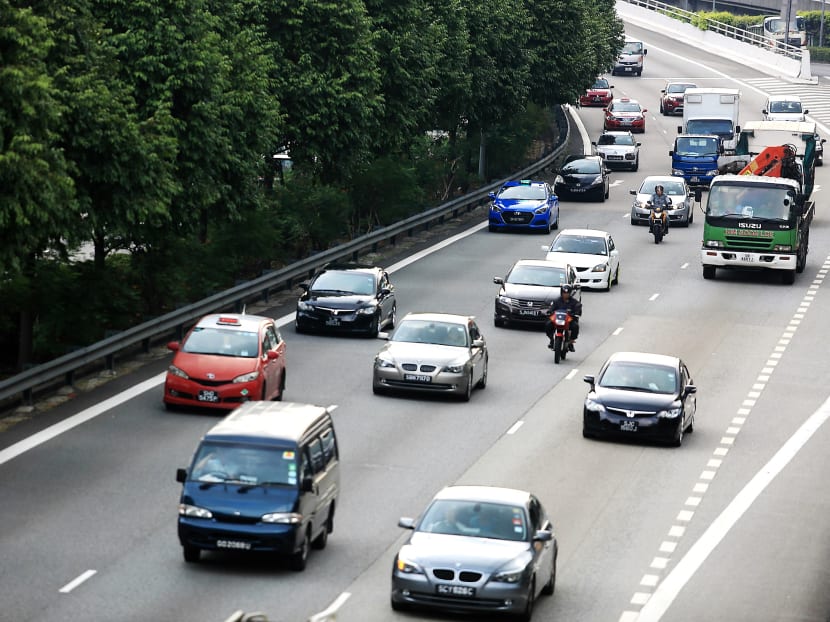New vehicle emissions scheme to include four more pollutants
SINGAPORE — A new Vehicular Emissions Scheme, taking into account four more pollutants apart from carbon dioxide, will replace an existing one from Jan 1 next year, in a bid to get motorists to buy environment-friendly vehicle models.
SINGAPORE — A new Vehicular Emissions Scheme, taking into account four more pollutants apart from carbon dioxide, will replace an existing one from Jan 1 next year, in a bid to get motorists to buy environment-friendly vehicle models.
The four pollutants to be introduced under the two-year scheme are nitrogen oxides, particulate matter, carbon monoxide and hydrocarbons.
Announcing the move in the Budget on Monday (Feb 20), Finance Minister Heng Swee Keat said that the new scheme would replace the Carbon Emissions-Based Vehicle Scheme (CEVS), which expires in June but will be extended until the year end.
Under the CEVS — last revised in 2015 — buyers who get vehicles with a low carbon footprint (135g of carbon emissions per km or less) qualify for rebates of between S$5,000 and S$30,000.
Conversely, those who buy carbon-intensive models that emit 186g of carbon per km or more will have to fork out a registration surcharge of between S$5,000 and S$30,000. Right now, emissions under the CEVS are measured only on the weight of carbon dioxide that a vehicle emits for every kilometre driven.
Mr Heng said that adding four more pollutants under the new scheme would “account more holistically for the health and environmental impact of vehicular emissions”. The new scheme will be reviewed before it expires in end-2019.
At a focus-group discussion in January, Environment and Water Resources Minister Masagos Zulkifli said that Singapore was committed to delivering clean air, but the country was not meeting its air-quality targets.
Based on last year’s figures, Singapore is not expected to hit the 2020 targets for pollutants that include sulphur dioxide, fine particulate matter (PM2.5), particulate matter (PM10) and ozone.
The pollutants being added mirror those that are regulated in other regions, such as Europe.
Under Australian emission standards, vehicles that run on petrol, liquefied petroleum gas or natural gas must meet limits for the emission of carbon monoxide, hydrocarbons and nitrogen oxides, while other vehicles, including those powered by diesel, must adhere to a limit for particulate-matter emissions.
Separately, Mr Heng also announced that a volume-based duty on automotive and industrial diesel, as well as biodiesel’s diesel component, kicked in on Monday, meaning some drivers will have to pay more at the pump. The S$0.10-a-litre duty aims to encourage users to cut diesel consumption, he said, adding that other cities from Athens to Paris have started taking action to reduce harmful diesel emissions.
But the impact from this will be offset for “the majority of drivers”, with a cut in an annual special tax on diesel vehicles regardless of the amount used. This special tax will be cut by S$850 for taxis and S$100 for cars.
“I strongly urge taxi companies to pass on the Special Tax reduction to taxi drivers,” added Mr Heng.
To help businesses adjust, owners of diesel buses and goods vehicles — except for omni-buses under the Government’s contracts for public bus services — will be granted a 100 per cent road-tax rebate for a year from August, which will be cut to 75 per cent in the second year and 25 per cent in the third.
In other announcements, the Early Turnover Scheme — introduced in 2013 to facilitate the early replacement of older and more pollutive commercial diesel vehicles through incentives — will be extended to July 2019 for vehicle owners to turn over their Euro 2 and 3 commercial diesel vehicles for Euro 6 ones.
Mr Heng revealed that 27,000 vehicles have been switched to cleaner models since the scheme’s roll-out.
Commenting on the new Vehicular Emissions Scheme, Mr Jeremy Soh, honorary secretary of the Singapore Vehicle Traders Association, is hopeful that it would nudge buyers towards getting more fuel-efficient vehicles.
The scheme would also prompt car distributors to relook their inventories to include more environment-friendly models, he added, because he does not see why consumers would buy a vehicle that does not draw more rebates.
Agreeing, Mr Neo Tiam Ting, president of the Automobile Importer & Exporter Association (Singapore), added that the motor industry would have time to prepare since the scheme kicks in only next year.
One suggestion from Mr Raymond Tang, first vice-president of the Singapore Vehicle Traders Association, is that instead of offsetting rebates from a vehicle’s Additional Registration Fee — as is with the existing CEVS — the new scheme should allow rebates to be channelled into consumers’ pockets, raising its effectiveness.
“The consumer (would then know) that the savings are there for him,” he said.
CORRECTION: In an earlier version of this report, we reported that the new scheme would expire in 2020. This is incorrect. The scheme will expire in end-2019. We apologise for the error.









